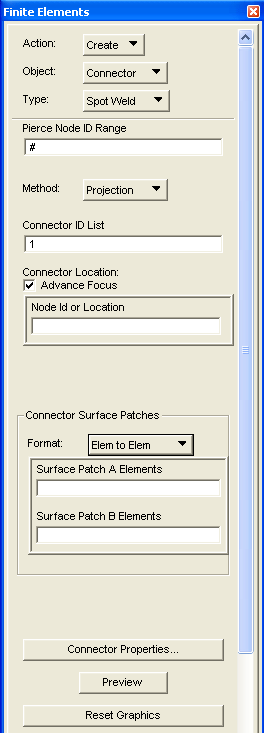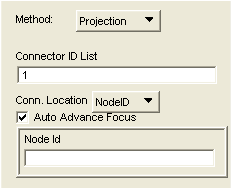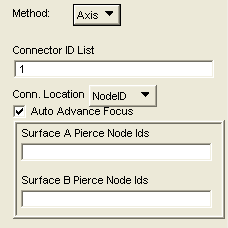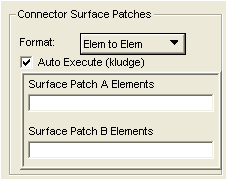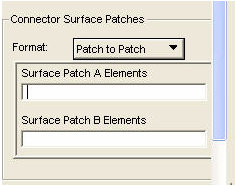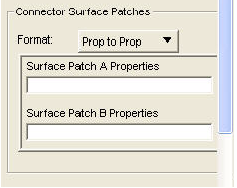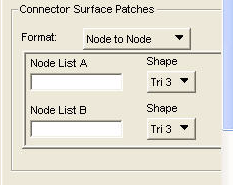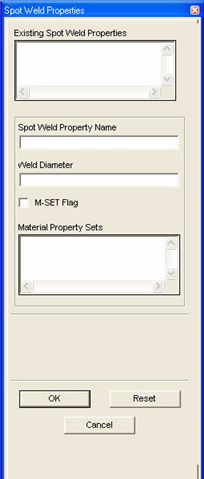XXXXXXXXXXXXXXXXXXXXXXXXXXXXXXXXXXXXXXXXXXXXXXXXXXXXXXXXXXXXXXXXXXXXXXXXXXXXXXXXXXXXXXXXXXXXXXXXXXXXXXXXXXXXXXXXXXXXXXXXXXXXXXXXXXXXXXXXXXXXXXXXXXXXXXXX''"> Creating Connectors
Creating connectors is used mainly for defining CWELD/PWELD and CFAST/PFAST (spot welds and fasteneres, respectively) in Nastran input decks. In general to define a connector, Nastran requires two points (GA and GB) to be specified that define the axis of the connector. These to points lie in the plane of the two surfaces that are being connected. Nastran also allows the user to specify a single point (GS) which is projected onto the two surfaces from which GA and GB are then determined. In Patran, if you use the "Axis" method, you must specifically give GA and GB to define the connector axis. If you use the "Project" method, this projection of the single point GS is done for you and GA and GB are determined from the projection. However, once the projection is done and GA/GB determined, the defnition of the connector in the database reverts to the "Axis" method and when written to a Nastran input deck only GA and GB are defined. Thus if you try to modify a connetor created with the "Projection" method, it will appear as if it were created by the "Axis" method. The "Projection" method is simply a convenient way to determine GA and GB within Patran.
If the user desires Nastran to use GS to determine GA and GB, the "Solver Project" method should be used. In this case, GA and GB are not written to the Nastran input deck but only GS, thus allowing Nastran to do the actual projection and determination of GA and GB.
In all cases, the top and bottom surfaces being connected must be specified and the connector properties must be given. The properties may be specified before creation using the Element Property application, or may be specified at the time of creation and an element properly entry will automatically be created. But in either case, the properties must be specified or creation will fail.
Creating Spot Weld Connectors
Method | Select from three methods for defining the Spot Weld location: Projection and Solver Project specify a node or point in space that is to be projected onto the two surfaces of the connector to determine the end points, GA and GB, which define the axis of the connector. “Axis” specifies nodes directly for GA and GB. |
Connector ID List | Displays the ID of the next connector that will be created |
Connector Location | The point specified for the Projection method is projected onto each surface. Nodes are generated at those locations, and the Pierce Nodes, GA and GB, are assigned node IDs. Nodes specified for the Axis method define the GA and GB piercing nodes directly. The Solver Project method specifies GS directly as a node or location and does not determine Pierce Nodes, GA +GB, but leaves this up to the solver to do. |
Format | Select from four formats: Elem to Elem (ELEMID and ALIGN formats, Patch to Patch (ELPAT format), Prop to Prop (PARTPAT format), and Node to Node (GRIDID format). The first three indicate the surfaces on to which the point will be projected to determine the pierce nodes GA+GB. |
• Elem to Elem | Top and Bottom shell elements defining the surface for the weld. If not specified, then both GA and GB are required (ALIGN format); otherwise, one top/bottom element pair per connector is required. Regardless of GA, GB, and the weld diameter, only a single element is connected. |
• Patch to Patch | Shell element on each surface defining the connecting surface patches (one pair per connector). Depending on the pierce locations (GA and GB) and the weld diameter, the number of connected elements may expand to up to a 3x3 element patch. |
• Prop to Prop | Properties associated with shell elements defining the connectivity of the weld (one pair per connector). Depending on the pierce locations (GA and GB) and the weld diameter, the number of connected elements may range from one element up to a 3x3 element patch. Multiple connector locations may be specified for a single property pair. The same pair will be used for each connector created. |
• Node to Node | Nodes (GAi and GBi) defining the connecting surface patches (one list pair per connector). The surface patches are defined as 3/6 node triangle or 4/8 node quad regions, the topology of which is indicated by SPTYP. If Node List B (GBi) is blank, then a point-to-patch connection is created. Topology of each surface patch: Tri3, Tri6, Quad 4, Quad 8. |
Connector Properties | Brings up the Spot Weld Properties form (PWELD attributes). |
Preview | Calculate/display/verify the connector (GS, GA, GB, and the connecting patches). |
Spot Weld Properties Form
The Spot Weld Properties form is used to define the PWELD parameters for a Spot Weld connector.
When a new spot weld connector is created, it references a connector property, specified in this form. If that connector property does not exist in the database, one is created. If it already exists, and all the values in the existing connector property are the same as those specified here, then the existing one is referenced. If, on the other hand, it already exists, but the values are different, a warning is posted, allowing the user to overwrite the existing property, if appropriate. The default response is not to overwrite, in which case the operation is aborted.
Connector properties may be modified via the Elements/Modify/Connector form. They cannot be deleted explicitly, but will be automatically deleted when the parent connector is deleted and no other connectors reference the connector property.
Connector Property Name | The connector property name (required). Select an exsting name from the above list, or type in a new one. |
Weld Diameter | The spot weld diameter (require, no default). |
Eliminate M-Set DOFs | M-Set DOF elimination flag (default OFF). |
Material Property Sets | The material property defining the weld material (required, no default). |
Creating Fastener Connectors
The GUI for creating fasteners (CFASTs) is consistent with that described above for the Spot Weld Connector.
There are two primary differences:
• CFAST only has two formats, PROP and ELEM. These are analogous to PARTPAT and ELPAT of CWELD, respectively.
• Other than the diameter specification, the PFAST properties are completely different than PWELD. They are:
D | The diameter (> 0.0, required) |
MCID | The element stiffness coordinate system (>= -1, default -1) |
MFLAG | = 0, MCID is relative (default)
= 1, MCID is absolute |
KTi | Stiffness values in directions 1-3 (real, required) |
KRi | Rotational stiffness values in directions 1-3 (default 0.0) |
MASS | Lumped mass of the fastener (default 0.0) |
